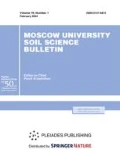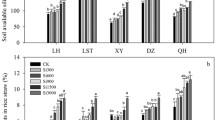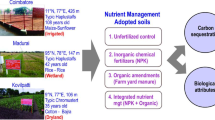Abstract
One of the most relevant tasks of modern agriculture is developing and implementing fundamentally new, available, environmentally safe “nature-like” technologies, providing a “sink” of carbon or a significant reduction in greenhouse gas emissions in all the agricultural landscapes, including those engaged in rice cultivation. In field trials conducted in Hunan province (China), the influence of silicon fertilizers on CO2 sequestration by rice plant roots was estimated. Its value depends on the content of available silicon in agrochemicals, on frequency and duration of their use, and on soil texture. The data obtained indicate the important role of silicon fertilizers in the processes of carbon sequestration and reduction of greenhouse gas emissions in rice cultivation. Their application results in increased crop yields by 12.1–71.2% and increased CO2 sequestration by plant roots by 0.95–14.9 t ha–1 in one season. Soil carbon recovery and soil fertility reproduction can be ensured by intensive development of the plant root system and by an increase in root residues’ mass after harvest. Agrochemicals containing silicon available for plants should be included in the 4R-strategy for mineral nutrition of agricultural crops.
Similar content being viewed by others
REFERENCES
Kulikova, A.Kh., Kremnii i vysokokremnistye porody v sisteme udobreniya sel’skokhozyaistvennykh kul’tur (Silicon and High-Silicon Rocks in Agricultural Plants Fertilizing System), Ulyanovsk, 2013.
Corsi, S., Pochvozashchitnoe i resursosberegayushchee zemledelie. Uchebnoe posobie (Soil Protecting and Resource Saving Agriculture. Student’s Book), Mumindzhanov, Kh., Ed., Ankara, 2017.
The State of Food Security and Nutrition in the World. Building Climate Resilience for Food Security and Nutrition, Rome, 2018.
4R-STRATEGIYa. Prakticheskoe rukovodstvo po primeneniyu udobrenii i optimizatsii pitaniya rastenii (4R-Strategy. Manual for Fertilizers Application and Optimizing Plants Nutrition), Moscow, 2017.
Adrees, M., Ali, S., Rizwan, M., et al., Mechanisms of silicon-mediated alleviation of heavy metal toxicity in plants: a review, Ecotoxicol. Environ. Saf., 2015, vol. 119, pp. 186–197.
Ali, M.A., Sattar, M.A., Islam, M.N., and Inubushi, K., Integrated effects of organic, inorganic, and biological amendments on methane emission, soil quality and rice productivity in irrigated paddy ecosystem of bangladesh: field study of two consecutive rice growing seasons, Plant Soil, 2014, vol. 378, nos. 1–2.
Bauer, P., Elbaum, R., and Weiss, I.M., Calcium and silicon mineralization in land plants: transport, structure and function, Plant Sci., 2011, vol. 180, no. 6.
Dakua, T.B., Rangan, L., and Mitra, S., Greenhouse gases emission from rice paddy ecosystem and their management, in Crop Improvement under Adverse Conditions, New York, 2013.
Dentener, F., Kinne, T., Bond, O., et al., Emissions of primary aerosol and precursor gases in the years 2000 and 1750 prescribed data-sets for AeroCom, Atmos. Chem. Phys., 2006, vol. 6, no. 12.
Haynes, R.J., Significance and role of Si in crop production, Adv. Agron., 2017, vol. 146, p. 83–166.
Ma, J.F. and Takahashi, E., Soil, Fertilizer, and Plant Silicon Research in Japan, Amsterdam, 2002.
Mullin, J.B. and Riley, J.P., The colorimetric determination of silicate with special reference to sea and natural waters, Anal. Chim. Acta, 1955, vol. 12, pp. 162–176.
Song, A., Fan, F., Yin, C., et al., The effects of silicon fertilizer on denitrification potential and associated genes abundance in paddy soil, Biol. Fertil. Soils, 2017, vol. 53, no. 6.
Sparks, D.L., Page, A.L., Helmke, P.A., et al., Methods of Soil Analysis, Part 3: Chemical Methods, Soil Science Society of America Book Series 5.3, Madison, 1996.
Yagi, K., Frontline research in mitigating greenhouse gas emissions from paddy fields, Soil Sci. Plant Nutr., 2018, vol. 64, no. 1.
Zhao, S., Lou, Y., Zhang, Y., et al., Effect of silicate supply on CH4 and N2O emissions and their global warming potentials in a chinese paddy soil under enhanced UV-B radiation, Acta Ecol. Sin., 2017, vol. 37, no. 14.
Funding
The study was carried out within the framework of the government project no. АААА-А17-117030110137-5 and АААА-А17-117030110139-9 partially funded by the Hunan Natural Science Fund Project (2018JJ3276); the China Central Guide, the Development of Local Science and Technology Special Foundation (2017XF5042); the Science and Technology Program of Changsha City (kq1706153); the Hunan Provincial Base for Scientific and Technological Innovation Cooperation (2018WK4013).
Author information
Authors and Affiliations
Corresponding authors
Additional information
Translated by A. Ivanitskaia
About this article
Cite this article
Dan-Dan, Z., Peng-Bo, Z., Bocharnikova, E.A. et al. Estimated Carbon Sequestration by Rice Roots as Affected by Silicon Fertilizers. Moscow Univ. Soil Sci. Bull. 74, 105–110 (2019). https://doi.org/10.3103/S0147687419030025
Received:
Revised:
Accepted:
Published:
Issue Date:
DOI: https://doi.org/10.3103/S0147687419030025




